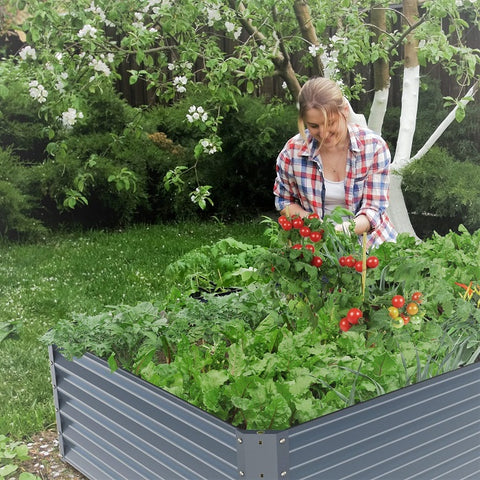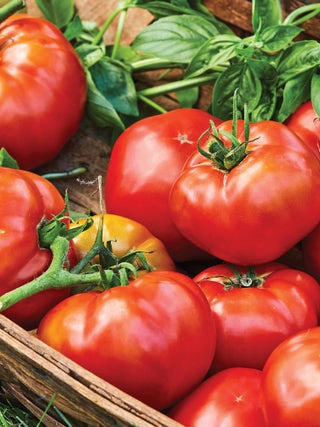The traditional tomato plant (Nightshade tomato) is naturally a sprawling vine, which comes as a surprise to some people who don't know how to garden. But this fact will not surprise those who know that tomatoes are related to the bitter sweet Solanum (Nightshade), a vine plant. Unlike Cucumis sativus, the cucumber is a true climbing plant with tendrils that allow it to grasp objects and climb. The following content also has some reference value for raised garden beds.
Conventional tomatoes will spread all over the ground unless you bother to place them on a support structure. Supporting tomatoes requires wooden stakes or metal cages and fasteners. Choose a fastener that won't cut through the vine. For example, bare thread is a poor choice, while fabric strips are a good choice because it is soft. You can usually recycle things from around the house to make your fasteners; Old pantyhose or socks will also work.

Read on to learn more about staking tomatoes in detail, each step, and the difference between staking "sure" and "uncertain" types of tomatoes.
Staking process
Nail the tomatoes to the stakes and use a loose tie to secure the vines to the cage or stakes every 6 to 8 inches as the tomatoes grow. Make sure the support is safely buried at least 1 foot underground to accommodate mature plants. Each tie should be about 1 inch above the flowering stem so that the tie does not poke into the stem when it is weighed down by the fruit.
Why do you put tomatoes on stakes
First of all, the tomato vine is very messy on the ground. But the reasons for supporting them go far beyond aesthetics:
- Let them grow along the ground can cause disease, and if they lie on wet ground, the fruit may rot.
- The absence of fixed plants makes the fruit more susceptible to being eaten by pests such as groundhogs and insects.
- Tomato plants that grow vertically are easier to care for. You don't have to worry about stepping on its vine to reach its fruit, and you don't have to bend so far to prune it or check it for pests and diseases.
- Letting tomatoes grow vertically saves space in the garden.
One of the downsides of vertical tomato growth is that it requires more water. Tomato vines grow along the ground, and the roots absorb extra moisture that they don't get when they're hanging on support.
Before we begin to stake
The first step in growing tomatoes is to determine if you are growing a definite or indeterminate type. An established plant grows to a predetermined size and produces all of its fruit in a period of about two weeks. Read the label on the seed package or tomato can to find out if a particular variety is certain or uncertain. Many modern hybrid tomato varieties are identified.

You will have less work to support a certain kind. It should still be a stake, but it will be a smaller vine, compact enough that it can grow in a container on a patio.
Supporting uncertain tomato plants is even more difficult because they get bigger and heavier. However, the traditional uncertain tomato plant will grow larger and produce more fruit. If properly cared for, it will continue to bear fruit until the first frost kills the plant.
What do you need
Equipment/Tools
Sledge hammer
Utility knife (if needed)
Materials
Tomato plant
Wooden or plastic stakes
Tomato cages
Shred
How to determine tomato with stake
01 Install cages or drive piles
You can simply buy a small or medium-sized tomato cage to grow tomatoes in. While it's young, put this support around it so you don't hurt it. The tomato plant will fill up its support as it grows, and you only need to tie it down in a few places, thanks to the compact form of the plant.
Or, you can use stakes to hold your tomatoes in place. The advantage of betting is that it costs less; The downside is that you have to be careful to tie the vine firmly to the stake (but not damage it), as the stake provides less support than the cage. So you have to choose between low maintenance and low cost. Another benefit of "sure tomatoes" for those who prefer low maintenance is that because they stay firm, you don't have to bother trimming the suckers.
Stakes can be made or purchased, but should be about 2 inches square and 4 to 7 feet tall, depending on the size of the variety you're planting. If necessary, trim the base of the stake to make it sharp. Drive it about 15 inches into the ground.
02 Secure the plant stem
Use strips of cloth (or elastic vinyl plant rope) to loosely secure the stem of the tomato plant to the cage or stake.

How to pile an uncertain tomato
01 Make a bet
An uncertain tomato stake should be at least 7 feet tall and 2 inches x 2 inches wide; The higher the better. It has to be firm, because a vine full of tomatoes can get heavy. The stake should be pointed at one end to make it easier to drive into the ground. If you bought one without a dot, trim off some wood at one end to create a dot.
02 Rigging bets
Use a small sledgehammer to drive the stake about 24 inches into the earth. Place stakes about 5 inches away from tomato plants so they don't damage the roots. Or, put all the stakes in place and plant the tomato seedlings.
03 Fixed stem
Use soft strips of cloth to secure the plant stems to the stakes. Alternatively, you can use elastic vinyl plant cords to hold the stems in place.
04 Trim away the suckers
Cut away suckers that SAP plant strength. These buds tend to grow in the space between the main stem and the fruiting branches. This pruning also improves air circulation and makes the plants less susceptible to disease.









